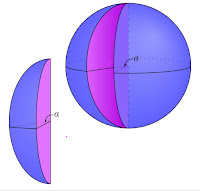UPDATE September 6, 2023: The rightmost L² term does affect the calculation of gravitomagnetism. We have to correct the calculation. See our post on September 4, 2023.
----
UPDATE September 5, 2023: In the radial correction we ignored the rightmost L² terms in:
we have to check how this affects the calculation.
----
UPDATE August 18, 2023: We correct the error we had in the radial acceleration term.
----
Test mass at a planar surface of a moving, thick body
\
\ R₀ = radius
dm' • • dm
r
V
^ β = angle V vs. (m, dm)
| /
|/
------------- • ----------------- ---> v
m surface
^ x
|
-----------> y
The mass density of the body is ρ. The surface is planar. Let us look at a thin slice whose center is at the test mass m and the radius R₀. The thickness of the slice is
k r',
Where r' is the distance from the axis which is parallel to the y axis and passes through m, and k > 0 is small.
We look at small parts of the body, dm' and dm, just like in the previous blog post. The distance (m, dm) is denoted by r. We have
r' = r sin(β).
The body moves to the right at a velocity v, and the test mass moves at a velocity V, which is normal to the surface.
The analysis about Lorentz corrections is the same as in the previous blog post.
The velocity of m relative to dm,
V' = V - v,
is the important vector.
• dm
v_r
^
|
• ----> v_t
m
Let us decompose V' into a radial velocity vector which points toward dm:
v_r = V cos(β) - v sin(β),
and the tangential velocity orthogonal to it:
v_ t = -V sin(β) - v cos(β).
Let us first determine the "radial acceleration" term.
The correction is -v_r² r_s / r². This is
-v_r² r_s / r² * sin(β)
in y acceleration. The corrections for dm' and dm almost cancel each other out, but leave for dm
da_y = 2 V cos(β) v sin(β) r_s / r² * sin(β).
We will integrate da_y together with tangential terms.
In newtonian gravity there is no tangential acceleration on the test mass, but relativistic corrections cause a tangential acceleration:
-v_r v_t * r_s / r²
in the Schwarzschild coordinates of dm.
We will study the four terms in -v_r v_t:
V² cos(β) sin(β)
+ V cos(β) v cos(β)
- V sin(β) v sin(β)
- v sin(β) v cos(β).
Just like like in the previous blog post we can show that only the second term and the third term contribute if v << V are both very small.
To obtain the acceleration a_y in the y direction, we have to multiply by cos(β).
The volume element of the slice is
k r' r dβ dr
= k r sin(β) r dβ dr.
The acceleration caused by the right half of the slice is, after adding da_y from above:
R₀ π / 2
a_y = ∫ V v ∫ cos³(β) + sin²(β) cos(β)
0 0
* 2 G / c² * 1 / r² * ρ k r sin(β)
* r dβ dr.
The integral
π / 2
∫ cos³(β) sin(β) + sin³(β) cos(β) dβ
0
π / 2
= ∫ sin(β) cos(β) dβ
0
= 1/2.
The integral, multiplied by two, is
2 a_y = V G / c² * 4 v ρ k R₀.
= V G / c² * 4 v * 1 / R₀² * 3/2 *
* ρ * 4/3 π R₀³ * k / (2 π)
= V G / c² * 6 v / R₀² * M,
where M is the mass of the slice.
Frame dragging by a moving long thin cylinder
R tan(β)
<-------->
dm' dm
=====•============•===== --> v
cylinder
r = distance (m, dm)
^ V
| / β = angle V vs. (m, dm)
| /
|/
• m R = distance(m, cylinder)
Let ρ be mass of the cylinder per length. The length element of the cylinder is
R (tan(β))' dβ
= R * 1 / cos²(β) dβ
The distance r is
r = R / cos(β).
The acceleration caused by the right half of the cylinder is:
π / 2
a_y = V v ∫ cos³(β) + sin²(β) cos(β)
0
* 2 G / c² * cos²(β) / R²
* ρ R * 1 / cos²(β) dβ
We have
π / 2
∫ cos³(β) + sin²(β) cos(β) dβ
0
π / 2
= ∫ cos(β) dβ
0
= 1.
Thus,
2 a_y = V * 4 G / c² * v ρ / R,
and the force
F = m V * 4 G / c² * v ρ / R.
Translated to the electromagnetic analogue:
F = q V * 4 μ₀ / (4 π) * I / R
= q V * 2 μ₀ / (2 π) * I / R.
where I is the electric current.
Gravitomagnetic frame dragging is 2 times the frame dragging caused by the analogue magnetic field.
Note that frame dragging by an analogous electrically charged cylinder does agree with gravitomagnetism. The magnetic field does not determine the total frame dragging in electromagnetism.
Conclusions
On August 5, 2023 we calculated that the gravitomagnetic frame dragging by a small moving massive body far away agrees with the electromagnetic analogue if we believe Calculation A in that blog post. The frame dragging is 2 times the dragging caused by the magnetic field alone (Calculation B).
Similarly, a gravitomagnetic "wire" frame drags at 2 times the intensity of the magnetic field around an analogous electric wire.
We will next look at Hans Thirring's results about frame dragging inside a rotating hollow sphere. Do they agree with our calculations?

No comments:
Post a Comment